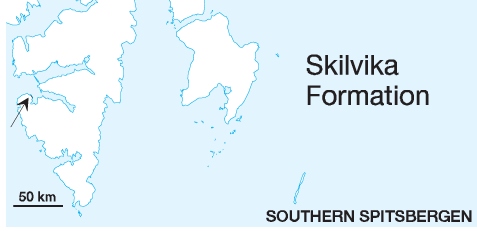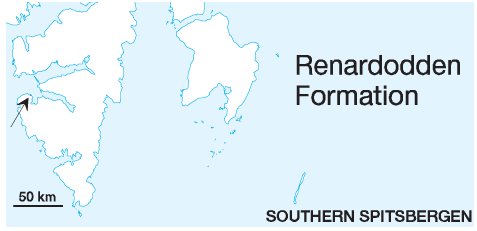|
CALYPSOSTRANDA GROUP (T-34) 
STATUS OF UNIT: Formal FIRST USE OF NAME: Here CURRENT DEFINITION: Here SYNONYM(S) AND REFERENCE(S): None. The unit has been called "Cenozoic of Kapp Lyell" and "Cenozoic of Renardodden" in various publications. ORIGIN OF NAME: Calypsostranda: A strandflat south of Bellsund TYPE AREA: Skilvika - Renardodden STRUCTURAL SETTING: West Spitsbergen Fold-thrust belt; probably a remainder of a Cenozoic sedimentary basin, whose main record is suggested to to lie offshore west of Spitsbergen DEPOSITIONAL AGE: Late Eocene - Early Oligocene OVERLYING UNIT(S): None UNDERLYING UNIT(S): Pre-Old Red SUPERIOR UNIT: None OTHER USE OF NAME: None THICKNESS: 265 m in the stratotype MAIN LITHOLOGIES: Sandstone, siltstone, shale, coal DESCRIPTION: The group comprises a sedimentary succession consisting of sandstones, siltstones, shales, coal seams and subordinate conglomerates, comprising the Cenozoic rocks of the Bellsund area. It unconformably overlies the Precambrian basement, but is – in outcrop – mostly separated from the basement by a fault. The strata probably belong to a larger basin extending into the western offshore area. For descriptions see the two individual Skilvika and Renardodden formations. SKILVIKA FORMATION (T-35) 
DISTRIBUTION shown in fig. 4-04 STATUS OF UNIT: Formal FIRST USE OF NAME: Livšic 1967 CURRENT DEFINITION: Livšic 1967 SYNONYM(S) AND REFERENCE(S): None ORIGIN OF NAME: Skilvika (transl.: "The Divide Bay"): A bay south of Bellsund, in the type area TYPE SECTION (fig. 4-49): Stratotype: Skilvika DEPOSITIONAL AGE: Late Eocene - Early Oligocene DATING METHOD: Palynology REFERENCE(S) FOR AGE: Head 1984 OVERLYING UNIT(S): Renardodden Formation UNDERLYING UNIT(S): Pre-Old Red SUPERIOR UNIT: Calypsostranda Group OTHER USE OF NAME: None THICKNESS: 103 m in the stratotype MAIN LITHOLOGIES: Sandstone, shale, coal, breccia LOWER BOUNDARY DEFINITION: The formation rests with an angular unconformity on Precambrian metasediments. A 4.3 m thick breccia occurs at the base of the formation. DESCRIPTION: There may be a slight unconformity between the basal breccia and the overlying strata. The Skilvika Formation otherwise consists of interbedded, often finingupwards, grey, fine-grained sandstones and dark siltstones/ claystones, with calcareous horizons in the middle part and abundant thin coal seams in the upper part (fig. 4-48). The formation is abruptly, possibly erosively, overlain by conglomerates and sandstones of the Renardodden Formation. The rocks contain abundant plant remains. (Atkinson 1963; Livšic 1967, 1974; Lehmann et al. 1978; Thiedig et al. 1979.) The Skilvika Formation represents a mainly fluvio-deltaic facies. The fine-grained nature of the formation suggests low depositional gradients and prolonged stability accompanied by gradual basin subsidence. Back to top RENARDODDEN FORMATION (T-36) 
DISTRIBUTION shown in fig. 4-04 STATUS OF UNIT: Formal FIRST USE OF NAME: Livšic 1967 CURRENT DEFINITION: Livšic 1967 SYNONYM(S) AND REFERENCE(S): None ORIGIN OF NAME: Renardodden: A cape south of Bellsund, type area TYPE SECTION (fig. 4-49): Stratotype: Skilvika - Renardodden DEPOSITIONAL AGE: Late Eocene - Early Oligocene DATING METHOD: Palynology REFERENCE(S) FOR AGE: Head 1984 OVERLYING UNIT(S): None UNDERLYING UNIT(S): Skilvika Formation SUPERIOR UNIT: Calypsostranda Group OTHER USE OF NAME: None THICKNESS: >160 m (exposed part of type section) MAIN LITHOLOGIES: Sandstone LOWER BOUNDARY DEFINITION: A 2.6 m thick conglomerate defines the base of the formation, associated with a possible unconformable (erosive) boundary with the underlying Skilvika Formation. DESCRIPTION: The Renardodden Formation consists of relatively monotonous, grey, fine to medium-grained sandstones, with some interbeds of dark grey siltstones and claystones, as well as streaks and thin seams of coal. The sandstones are loosely cemented and contain numerous siderite concretions and Ophiomorpha burrows. The top of the formation is truncated by the Quaternary unconformity. (Atkinson 1963; Livšic 1967, 1974; Lehmann et al. 1978; Thiedig et al. 1979.) Back to top |

